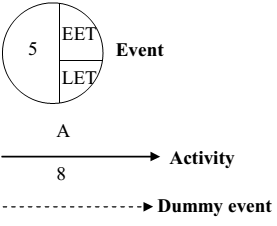What type of symbols used to create a network diagram?
Symbols used to create a network diagram are as illustrated:
An arrow is utilized to represent each activity or event to accomplish, the letter above the arrow shows the activity ‘in shorthand’ as well as the interval of the activity is recorded below the arrow for example hours, months or days.
Every activity or task which happens, has a preceding event or circles and every circle is pre-numbered for example above circle 5 is utilized as an illustration to show that would be the 5th event or circle to be finished in the diagram.

Symbols used to create a network diagram
The earliest event time (EET) for an activity is recorded within the circle preceding every activity (shown by an arrow) like you work from left to right. The earliest event time displays the earliest time an activity (symbolized by an arrow) can begin specified the interdependence of other activities which would be completed beforehand.
The latest event time (LET) for an activity is recorded into the circle given the activity (arrow) for example the latest time activity should be completed by, sequentially to attain the elapsed time of the project.
A dummy event (or activity) is utilized while a task or activity (symbolized by an arrow) follows more than one preceding activity for example the arrow could be drawn by more than one potential circle into the demonstration. When an activity relies on more than one activity to be finished beforehand, sketch the activity (arrow) by the circle along with the highest earliest event time (to preserve the diagrams logic), in that case link all probable circles together, which the activity could have been connected to by using dummy activities for example a broken or dotted arrow.